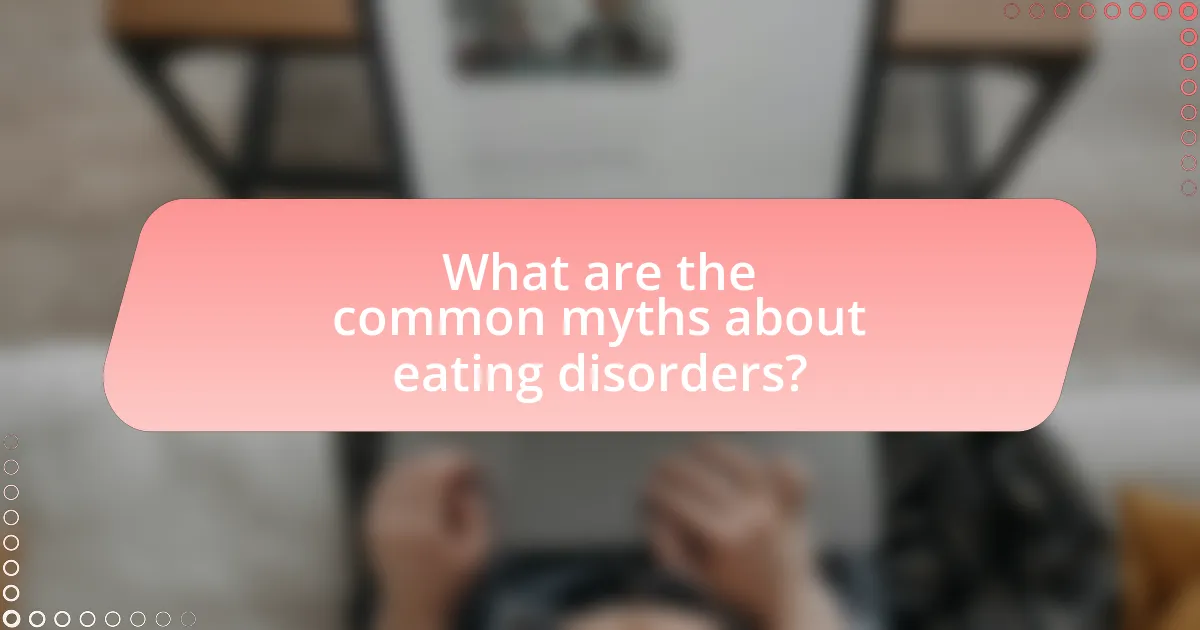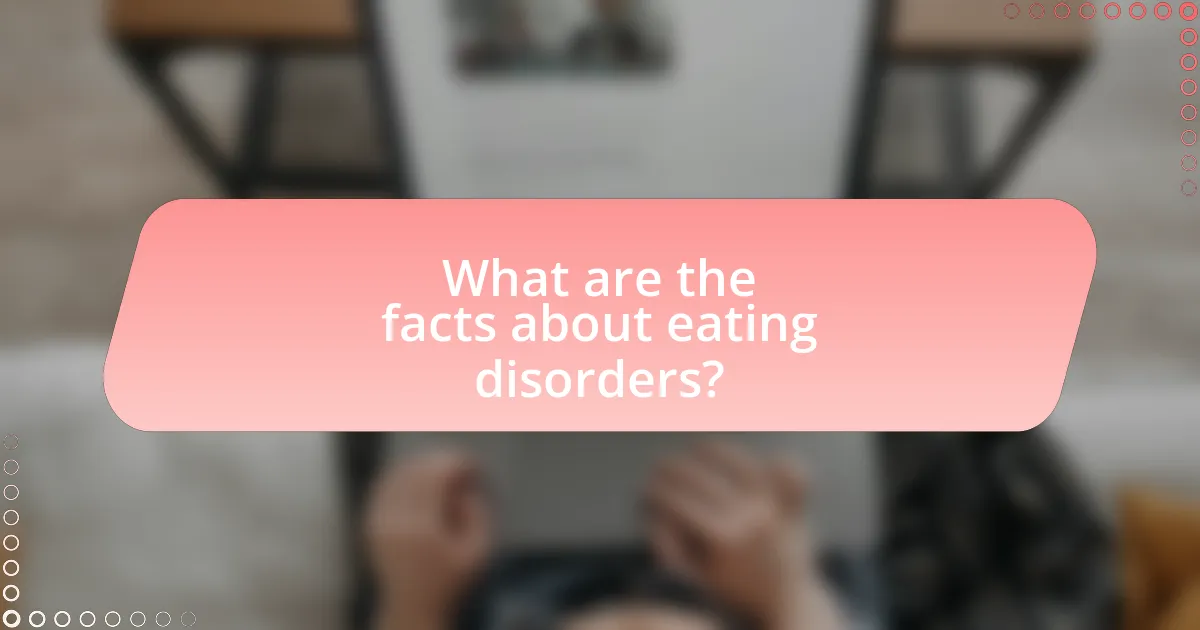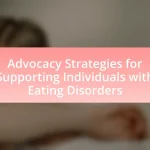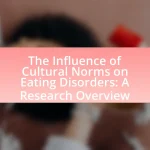The article “Debunking Myths About Eating Disorders: Facts vs. Fiction” addresses prevalent misconceptions surrounding eating disorders, emphasizing that these complex mental health conditions can affect individuals of all genders, ages, and body types. It highlights the impact of myths on public perception, which can lead to stigma and hinder treatment accessibility. The article also discusses the role of media in perpetuating these myths and the importance of accurate information in fostering understanding and support for those affected. Key statistics reveal the significant prevalence and serious health implications of eating disorders, underscoring the necessity for education and awareness to combat misinformation and promote effective treatment.

What are the common myths about eating disorders?
Common myths about eating disorders include the belief that they only affect young women, that they are a choice or a phase, and that individuals with these disorders are always underweight. In reality, eating disorders can affect people of all genders, ages, and body types; they are complex mental health conditions influenced by various factors, including genetics and environment. According to the National Eating Disorders Association, approximately 10 million men in the U.S. will experience a clinically significant eating disorder at some point in their lives, highlighting that these disorders are not limited to women. Furthermore, the notion that eating disorders are merely about food is misleading; they often stem from deeper psychological issues.
How do these myths impact public perception of eating disorders?
Myths about eating disorders significantly distort public perception by perpetuating stereotypes and misinformation. For instance, the belief that eating disorders only affect young, thin, white females leads to a lack of recognition for individuals of diverse backgrounds and body types who also struggle with these conditions. Research from the National Eating Disorders Association indicates that this narrow view can prevent people from seeking help, as they may not identify with the stereotypical image of an individual with an eating disorder. Additionally, myths that suggest eating disorders are a choice or a phase undermine the seriousness of these mental health issues, contributing to stigma and misunderstanding. This stigma can discourage open conversations and support, further isolating those affected.
What role does media play in perpetuating these myths?
Media plays a significant role in perpetuating myths about eating disorders by shaping public perception and reinforcing stereotypes. Through the portrayal of unrealistic body standards, sensationalized stories, and the glorification of thinness, media outlets contribute to the misunderstanding of the complexities surrounding eating disorders. Research indicates that exposure to media images that idealize thinness can lead to body dissatisfaction and disordered eating behaviors, particularly among young audiences. For instance, a study published in the journal “Eating Disorders” found that individuals who frequently consume media content featuring thin models are more likely to develop negative body image and engage in unhealthy eating practices. This evidence underscores the media’s influence in maintaining harmful myths about eating disorders.
How can misinformation lead to stigma surrounding eating disorders?
Misinformation can lead to stigma surrounding eating disorders by perpetuating false beliefs about their causes and characteristics. For instance, the misconception that eating disorders only affect young, thin females ignores the reality that these disorders can affect individuals of all genders, ages, and body types. This narrow view fosters stigma by suggesting that those who do not fit this stereotype are less deserving of help or understanding. Research indicates that stigma can exacerbate the severity of eating disorders and hinder individuals from seeking treatment, as they may fear judgment or misunderstanding from others. A study published in the International Journal of Eating Disorders found that stigma significantly impacts the willingness of individuals to seek help, highlighting the detrimental effects of misinformation on public perception and treatment accessibility.
Why is it important to debunk these myths?
Debunking myths about eating disorders is crucial because misinformation can perpetuate stigma and hinder effective treatment. Accurate understanding allows individuals to recognize the seriousness of these disorders, which affect millions globally; for instance, the National Eating Disorders Association reports that 20 million women and 10 million men in the U.S. will experience an eating disorder at some point in their lives. By clarifying misconceptions, we promote empathy, encourage those affected to seek help, and foster a supportive environment that prioritizes mental health and recovery.
What are the consequences of believing in these myths?
Believing in myths about eating disorders can lead to harmful consequences, including stigma, misunderstanding, and inadequate treatment. Stigmatization occurs when individuals with eating disorders are judged based on misconceptions, which can deter them from seeking help. Misunderstanding these disorders may result in friends and family providing inappropriate support, further exacerbating the individual’s condition. Additionally, inadequate treatment arises when healthcare providers rely on myths rather than evidence-based practices, leading to ineffective care. Research indicates that misconceptions about eating disorders can contribute to a lack of awareness and resources, ultimately hindering recovery efforts.
How can debunking myths improve understanding and treatment?
Debunking myths improves understanding and treatment of eating disorders by providing accurate information that challenges misconceptions. When myths are dispelled, individuals gain a clearer perspective on the nature of eating disorders, which can lead to more effective treatment options. For instance, research indicates that many people believe eating disorders only affect young women, but studies show that they can impact individuals of any age, gender, or background. This understanding encourages a broader recognition of the issue, leading to increased awareness and support for diverse populations affected by these disorders. Furthermore, accurate information can reduce stigma, allowing individuals to seek help without fear of judgment, ultimately improving treatment outcomes.

What are the facts about eating disorders?
Eating disorders are serious mental health conditions characterized by abnormal eating habits that can negatively impact physical and emotional health. According to the National Eating Disorders Association, approximately 20 million women and 10 million men in the United States will experience a clinically significant eating disorder at some point in their lives. These disorders include anorexia nervosa, bulimia nervosa, and binge-eating disorder, each with distinct symptoms and health risks. Research published in the journal “Psychological Medicine” indicates that eating disorders have the highest mortality rate of any mental illness, highlighting the critical need for awareness and treatment.
How do eating disorders manifest in different individuals?
Eating disorders manifest in different individuals through a variety of symptoms and behaviors, which can include restrictive eating, binge eating, purging, and excessive exercise. For instance, anorexia nervosa often presents as extreme weight loss and an intense fear of gaining weight, while bulimia nervosa may involve cycles of binge eating followed by purging behaviors. Additionally, individuals with binge eating disorder typically experience episodes of consuming large quantities of food without compensatory behaviors. Research indicates that these disorders can also be influenced by psychological factors, such as anxiety and depression, and may vary based on cultural and social contexts, highlighting the complexity of their manifestation across different individuals.
What are the signs and symptoms of various eating disorders?
Eating disorders manifest through a range of signs and symptoms that vary by type. Anorexia nervosa is characterized by extreme weight loss, an intense fear of gaining weight, and a distorted body image. Bulimia nervosa involves cycles of binge eating followed by purging behaviors, such as vomiting or excessive exercise, often accompanied by feelings of shame. Binge eating disorder is marked by recurrent episodes of eating large quantities of food, often in a short period, without compensatory behaviors, leading to distress and feelings of loss of control. Other symptoms across these disorders may include changes in mood, social withdrawal, and physical health issues like gastrointestinal problems or electrolyte imbalances. These symptoms are supported by clinical observations and research, such as the Diagnostic and Statistical Manual of Mental Disorders (DSM-5), which outlines specific criteria for diagnosing these conditions.
How do eating disorders affect physical and mental health?
Eating disorders significantly impair both physical and mental health. Physically, they can lead to severe malnutrition, electrolyte imbalances, heart complications, and gastrointestinal issues, with studies indicating that individuals with anorexia nervosa have a mortality rate of up to 10%, primarily due to medical complications. Mentally, eating disorders are associated with increased rates of anxiety, depression, and substance abuse, with research showing that approximately 50% of individuals with eating disorders also experience mood disorders. These conditions create a cycle of distress that exacerbates both physical and psychological symptoms, highlighting the critical need for comprehensive treatment approaches.
What are the statistics surrounding eating disorders?
Eating disorders affect approximately 9% of the global population, with the prevalence being higher among women, who account for about 70% of those affected. According to the National Eating Disorders Association, around 30 million Americans will experience an eating disorder in their lifetime. Furthermore, the World Health Organization reports that eating disorders have the highest mortality rate of any mental illness, with 10% of individuals suffering from anorexia dying within 10 years of diagnosis. These statistics highlight the significant impact and seriousness of eating disorders in society.
How prevalent are eating disorders in different demographics?
Eating disorders are prevalent across various demographics, with significant variations in incidence rates. Research indicates that approximately 9% of the U.S. population will experience an eating disorder in their lifetime, with higher rates observed among females, particularly young women aged 18-24, where the prevalence can reach up to 13%. Additionally, studies show that individuals in the LGBTQ+ community report higher rates of eating disorders compared to their heterosexual counterparts, with some estimates suggesting that up to 15% of LGBTQ+ individuals may be affected. Furthermore, cultural factors influence prevalence, as certain ethnic groups may experience different rates; for instance, Asian American women have shown increasing rates of eating disorders, reflecting a shift in cultural pressures. These statistics underscore the importance of recognizing the diverse impact of eating disorders across different demographic groups.
What trends are observed in eating disorder diagnoses over time?
Eating disorder diagnoses have shown a significant increase over time, particularly among adolescents and young adults. Research indicates that the prevalence of eating disorders, such as anorexia nervosa and bulimia nervosa, has risen notably since the late 20th century, with a 2019 study published in the Journal of Eating Disorders reporting a 70% increase in diagnoses among young women from 2000 to 2018. Additionally, the COVID-19 pandemic has exacerbated this trend, leading to a surge in cases, as highlighted by a 2021 report from the National Eating Disorders Association, which noted a 40% increase in helpline calls. These statistics underscore a growing recognition and diagnosis of eating disorders, reflecting both increased awareness and possibly rising incidence rates.

How can we effectively address and combat these myths?
To effectively address and combat myths about eating disorders, education and awareness campaigns must be implemented. These initiatives should focus on providing accurate information about the nature, causes, and consequences of eating disorders, countering misinformation prevalent in society. Research indicates that educational programs can significantly reduce stigma and misconceptions; for instance, a study published in the Journal of Eating Disorders found that targeted interventions improved knowledge and attitudes towards eating disorders among participants. By utilizing evidence-based resources and engaging with communities, we can foster a more informed public that recognizes the complexities of eating disorders, ultimately leading to better support for those affected.
What strategies can be employed to educate the public?
To educate the public about eating disorders, strategies such as awareness campaigns, community workshops, and educational materials can be employed. Awareness campaigns utilize social media and public service announcements to disseminate accurate information, reaching a broad audience effectively. Community workshops provide interactive learning experiences, allowing participants to engage with experts and ask questions, which enhances understanding. Educational materials, including brochures and online resources, offer accessible information that can be shared widely. Research indicates that targeted educational interventions can significantly improve knowledge and reduce stigma surrounding eating disorders, as demonstrated in studies published in journals like the International Journal of Eating Disorders.
How can healthcare professionals contribute to myth-busting?
Healthcare professionals can contribute to myth-busting by providing accurate information and evidence-based education about eating disorders. They can utilize their expertise to clarify misconceptions, such as the belief that eating disorders only affect young women, by presenting data that shows these disorders can affect individuals of any age, gender, or background. For instance, the National Eating Disorders Association reports that 10 million men in the U.S. will experience a clinically significant eating disorder at some point in their lives, highlighting the need for inclusive awareness. By engaging in community outreach, offering workshops, and utilizing social media platforms, healthcare professionals can effectively disseminate factual information, countering prevalent myths and fostering a better understanding of eating disorders.
What role do support groups play in dispelling myths?
Support groups play a crucial role in dispelling myths about eating disorders by providing accurate information and shared experiences that counter misinformation. These groups facilitate open discussions where individuals can share their personal stories, which helps to normalize the conversation around eating disorders and challenge stereotypes. Research indicates that peer support can significantly reduce stigma and misconceptions, as participants learn from each other and gain insights into the realities of these conditions. For instance, a study published in the Journal of Eating Disorders found that individuals who engaged in support groups reported a better understanding of their disorders and a decrease in feelings of isolation, which directly combats prevalent myths.
What resources are available for further education on eating disorders?
Resources available for further education on eating disorders include organizations, websites, and literature dedicated to the subject. Notable organizations such as the National Eating Disorders Association (NEDA) provide comprehensive information, support, and educational materials on various eating disorders. The Academy for Eating Disorders (AED) offers research publications and guidelines for professionals and the public. Additionally, academic journals like the International Journal of Eating Disorders publish peer-reviewed studies that contribute to the understanding of eating disorders. These resources collectively enhance knowledge and awareness, supporting both individuals affected by eating disorders and those seeking to educate themselves on the topic.
How can individuals access reliable information about eating disorders?
Individuals can access reliable information about eating disorders through reputable organizations, academic journals, and healthcare professionals. Organizations such as the National Eating Disorders Association (NEDA) and the Academy for Eating Disorders (AED) provide evidence-based resources, support, and educational materials. Academic journals like the International Journal of Eating Disorders publish peer-reviewed research that offers insights into the latest findings and treatment options. Consulting healthcare professionals, including registered dietitians and mental health specialists, ensures access to accurate and personalized information regarding eating disorders.
What are some recommended organizations and websites for support?
Some recommended organizations and websites for support regarding eating disorders include the National Eating Disorders Association (NEDA), which provides resources, support groups, and a helpline for individuals seeking help. Another valuable resource is the Eating Disorders Coalition, which advocates for policy change and offers educational materials. Additionally, the Academy for Eating Disorders (AED) provides research and clinical guidelines to support treatment. These organizations are recognized for their commitment to raising awareness and providing assistance to those affected by eating disorders.
What practical steps can individuals take to support those with eating disorders?
Individuals can support those with eating disorders by fostering a non-judgmental environment and encouraging open communication. This involves actively listening to their concerns without offering unsolicited advice or criticism, which can help build trust. Additionally, individuals should educate themselves about eating disorders to understand the complexities involved, as this knowledge can guide their interactions and responses.
Offering practical assistance, such as accompanying the person to therapy sessions or helping them find resources, can also be beneficial. Research indicates that social support plays a crucial role in recovery, with studies showing that individuals with strong support systems are more likely to engage in treatment and experience positive outcomes.


